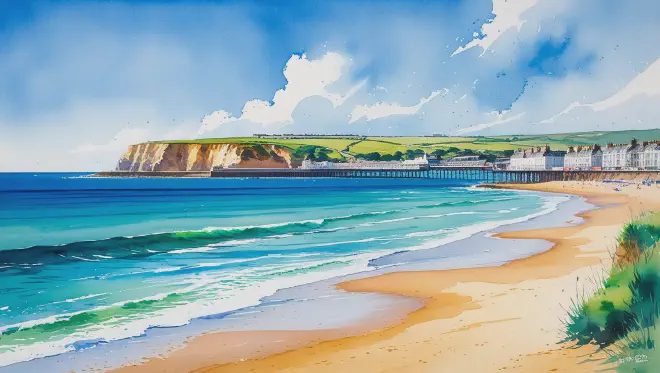Introduction
When I speak the name Bournemouth aloud, I can almost catch the scent of the sea drifting through the air. This seaside town in Dorset, southwest England, has been known as an elegant resort destination since the Victorian era. Its eleven-kilometer stretch of golden sand is among the most beautiful in Britain, and the unique landscape created by clifftop bays resembles a painting crafted by nature itself.
The town center is dotted with Victorian and Edwardian buildings constructed from the late 19th to early 20th centuries. Combined with the mild climate, there’s an illusion that time flows more slowly here. The presence of Bournemouth University brings youth to the area, creating that distinctive atmosphere of southern England where tradition and modernity blend harmoniously.
I chose this town because I wanted to escape London’s hustle and bustle, to quiet my mind while listening to the sounds of the sea. In these brief three days and two nights, how deeply could I touch the quiet charm this place holds?

Day 1: Arrival Wrapped in Sea Breezes
After a two-hour train journey from London’s Waterloo Station, the moment I stepped onto the platform at Bournemouth station, I could tell the air was different. A breeze carrying the faint fragrance of salt caressed my cheek, filling me with an oddly nostalgic feeling. The station building wasn’t particularly large, but its red brick exterior radiated warmth, giving me an excellent first impression of the town.
Walking toward my B&B accommodation, I took in the town’s character along the way. Bournemouth’s city center was surprisingly compact, with cafes, restaurants, and small boutiques scattered within walking distance. Most buildings were unified in white or cream colors, with lush parks positioned throughout, creating an overall bright and open atmosphere.
Around 2 PM, I finally checked into my B&B. Mrs. Harris, the owner, was an elegant woman in her mid-sixties who kindly asked, “Is this your first time in Bournemouth?” Following her recommendation, I decided to head from the town center toward the coast. “It’s about a ten-minute walk to the pier. With weather this lovely, you’re sure to see a wonderful view.”
The path to Bournemouth Pier follows a gentle downward slope. Passing through the beautiful park called Lower Gardens, the sound of the sea gradually grew louder. Then, the moment I descended the steps, I was greeted by a breathtakingly beautiful coastline.
The golden sandy beach curved in an arc, with Poole Bay stretching beyond and the white limestone formations of Old Harry Rocks visible in the distance. The pier itself, constructed in 1880, is a historic structure whose wooden walkway extending into the sea seemed to blur the boundary between land and water.
Walking to the pier’s end, the sea breeze felt pleasant against my cheek. To the left, I could see all of Bournemouth’s townscape, while to the right stretched an endless coastline. With few tourists around, I could spend a quiet afternoon moment with the sea.
As evening fell, I had dinner at “The Reef,” a restaurant near the pier. Seated on the terrace with its sea view, I ordered fish and chips made with locally caught fish. The batter was light and crispy, the white fish inside perfectly flaky, and when I squeezed lemon over it, the refreshing acidity harmonized beautifully with the sea’s saltiness. The accompanying mushy peas had that distinctive southern English sweetness, somehow rustic and warming in flavor.
After finishing my meal, I stepped outside to find the sunset reflecting on the sea’s surface, creating an orange pathway of light. The pier was softly illuminated, showing a completely different expression from daytime. With only the sound of waves quietly echoing, the first night in this town gently deepened. Walking back to the B&B, the peaceful atmosphere of the residential streets lit by streetlamps somehow put my heart at ease.
Day 2: A Day Touching Nature and History
At 8 AM, my day began with the full English breakfast Mrs. Harris had prepared. Eggs, bacon, sausages, grilled tomatoes, and black pudding were beautifully arranged on the plate, with thick-cut toast and marmalade on the side. The tea was Earl Grey, which she particularly recommended, its bergamot fragrance dissolving into the morning air.
“Where are you off to today?” she asked. When I mentioned my plans to visit Corfe Castle and Durdle Door, her eyes lit up: “Wonderful choice! The view at Durdle Door especially is breathtaking.”
At 9:30 AM, I took the train from Bournemouth station to Corfe Castle station. The pastoral scenery visible through the carriage windows embodied the quintessential English countryside beauty. Rolling hills dotted with sheep flocks, green pastures divided by stone walls creating geometric patterns.
I arrived at Corfe Castle around 10:30 AM. Built by the Normans in the 11th century, these castle ruins were destroyed by Parliamentary forces during the English Civil War, yet their ruined beauty was exceptional. The stone walls and towers standing proudly atop the hill, looking down over the surrounding village, gave me the sensation of having traveled back to medieval times.
Walking through the castle’s interior while listening to the guide’s explanations, I felt the weight of history this castle had witnessed. From the highest viewing platform, the breathtaking view across the Purbeck countryside revealed a carpet-like expanse of green fields stretching toward the sea.
Around 2 PM, I left Corfe Castle for Durdle Door. This area is part of the Jurassic Coast, designated a UNESCO World Heritage Site in 2001, a precious location where geological layers from 185 to 65 million years ago are exposed. The coastline visible from the train window was striking with its white limestone cliffs, small coves nestled between them.
Walking down the footpath from Durdle Door’s car park to the coast, the salt fragrance gradually intensified. Then suddenly before me appeared the limestone arch standing alone in the sea - Durdle Door itself. This natural arch, approximately 45 meters high, was carved over countless years by wave erosion, possessing a grandeur that photographs could never convey.
Walking along the coast, I picked up various fossils and beautiful pebbles scattered at my feet. Here you can actually find fossils of ammonites and belemnites - a mysterious experience like holding Earth’s history in your hands.
Around 5 PM, I returned to Bournemouth and extended my walk to Boscombe Pier on the town’s eastern side. Smaller and quieter than Bournemouth Pier, this jetty is also popular with surfers. Watching people ride the waves in the evening light, I enjoyed cream tea at the seaside cafe “Chez Fred.”
The scones were warm, the rich flavor of clotted cream and the sweet-tart strawberry jam creating perfect harmony. I chose Darjeeling tea, and with its mellow fragrance, I felt the day’s fatigue pleasantly melting away.
That evening, I spent time with locals at “The Four Horsemen,” a pub in the town center. This establishment has been running since the 1920s, its interior embodying the classic British pub. The fireplace provided warmth, wooden tables and chairs showing the character of long use. I ordered the local beer “Badger” and, in the pub’s characteristic warm atmosphere, exchanged words with an elderly local couple sitting beside me.
“How do you find Bournemouth?” they asked. When I replied that it was a wonderful place, they smiled: “We’ve lived here for forty years, but we still feel happy every time we see the sea.” In their words, I sensed the love the people here hold for their land.
Day 3: Farewell and Lingering Memories
On my final morning, I woke earlier than usual. With time to spare before checkout, I decided to take a solitary walk to the coast. The beach at 7 AM was still quiet of tourists, with locals enjoying their morning jogs and dog walks.
Walking to the pier and standing at the jetty’s end, the morning sea showed a completely different face from the previous days. Through thin mist hanging over the horizon, the sun slowly began to rise, the sea surface gleaming gold. Even the sound of the waves differed from night - somehow filled with life-force and strength.
“Beautiful morning, isn’t it?” came a voice from behind. Turning, I saw a middle-aged man with his dog. “Yes, truly,” I replied, and he told me, “I walk here every morning, but this view never fails to captivate me. It’s Bournemouth’s treasure.”
Returning to the B&B, Mrs. Harris had prepared my final breakfast. Though it was the same full English breakfast as yesterday, this morning it seemed especially delicious. “How was Bournemouth for you?” she asked. When I answered that it had been truly wonderful, she offered warm words: “Please do come back again. This town will always welcome you.”
At 10 AM, after checking out with my luggage, I set off for one last exploration. First, I decided to walk through Bournemouth Gardens in the town center. This park spreads along the Bourne River flowing through the town’s heart, a beautiful garden where various flowers and trees are carefully tended to provide enjoyment throughout the seasons.
The park contains a small cafe where I had my final cup of tea while reflecting on these three days. The weight of history felt at Corfe Castle, the natural sculptural beauty seen at Durdle Door, and above all, the warmth of the people I met. Though my stay was brief, I could feel something being permanently deposited in my heart.
At noon, walking toward the station, I thought I should take one more look at the sea and stopped at the viewing platform in Upper Gardens. From here, Bournemouth’s entire coastline was visible, the pier and beaches I had walked clearly in view. The blue sea, golden sand, and lush townscape all harmonized like a single beautiful painting.
As train time approached, I walked toward the station with heavy steps. Waiting on the platform, I suddenly realized something. In this town, everyone seemed to live at their own pace, enjoying life without being chased by time. Perhaps in the presence of the sea - such vast nature - human anxieties and small worries become meaningless.
Boarding the 1:15 PM train, I watched Bournemouth’s townscape recede through the window. By the time the carriage left the coastline for the inland areas, a quiet satisfaction had spread through my heart.
In Closing: What Felt Real Despite Being Imaginary
This journey was fictional - I never actually set foot on Bournemouth’s soil. Yet strangely, even now, the scent of sea breeze, Mrs. Harris’s warm smile, the pastoral view from Corfe Castle, and Durdle Door’s magnificent form remain in my heart as if truly experienced.
Perhaps travel isn’t simply about moving between places, but about accumulating something within ourselves through encounters with new landscapes and people. Even if the experience exists only in imagination, if our hearts are moved and emotions stirred, perhaps that truly constitutes “having traveled.”
What Bournemouth taught me was the importance of spending time slowly, human humility before nature, and the warmth that allows strangers to connect heart to heart. These sensations, though imaginary, have certainly taken root within me and will surely make my days ahead a little richer.
The sound of the sea still quietly resonates deep in my heart.

